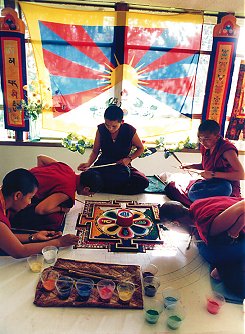| Tibetische Nonnen aus Kathmandu zum ersten mal auf Tour in Deutschland Oktober/November/Dezember 2000 |
| Tibetische Nonnen aus Kathmandu zum ersten mal auf Tour in Deutschland Oktober/November/Dezember 2000 |
Die sakrale Kunst der Sandmandala-Streuung
|
|
| Training the nuns in
Buddhist philosophy and debate is not the only innovation at KGN. The nuns are now
receiving education in the full range of ritual arts, including music, sacred dance, and
sand mandala painting. All of these ritual arts are integral parts of the meditative
practices that Tibetans have been performing since the beginning of Tibetan monasticism in
the ninth century. Only now, through the innovation of KGN, the nuns have a far more profound understanding of the symbolic meaning of their rituals, and they have taken control of their own ritual life. They are no longer dependent on others to perform the aspects of Buddhist rituals that were once out of bound to women. Among the Tibetan arts, the one that has astonished and moved North American audiences wherever it has been performed and displayed is the art of sand mandala painting. |
 |
|
Medicine Buddha sand mandala |
A sand mandala is a
two-dimensional geometric design, drawn in coloured sand, that represents the celestial
palace of a particular emanation of the Buddha. In their ritual function mandalas are most
commonly created in connection with a tantric "initiation," in which a
practitioner receives the empowerment or permission to enter into the practice of a
particular Buddha; this is carried out by the initiate symbolically gaining entrance into
the mandala. From that point on the initiate becomes a devotee or practitioner of
the path of that Buddha, and throughout their lives they will reproduce the mandala within
the visualized sphere of their own imagination. The mandala now comes to represent
the psycho-cosmic universe in which the Buddha carries out his or her spontaneous activity
of leading all beings to happiness and peace through the emanation of unlimited love and
compassion, and the pointing out of transcendent discriminating wisdom. The most requested sand mandalas have been those of the Compassion Buddha, Thousand-Armed Chenrezig, and of Medicine Buddha. |
Links on sand mandalas
|
Die Aufführung | Rituelle Musik | Sandmandala | Die Nonnen | Image Galerie
Benefiz Aktion | Auftritte | Hinweise für örtliche Veranstalter | Ihre
Hilfe ist sehr willkommen! | WWW-links
© Khachoe Ghakyil 1999-2000
Web custodian Julia Milton
Hosted by Women Active in Buddhism.